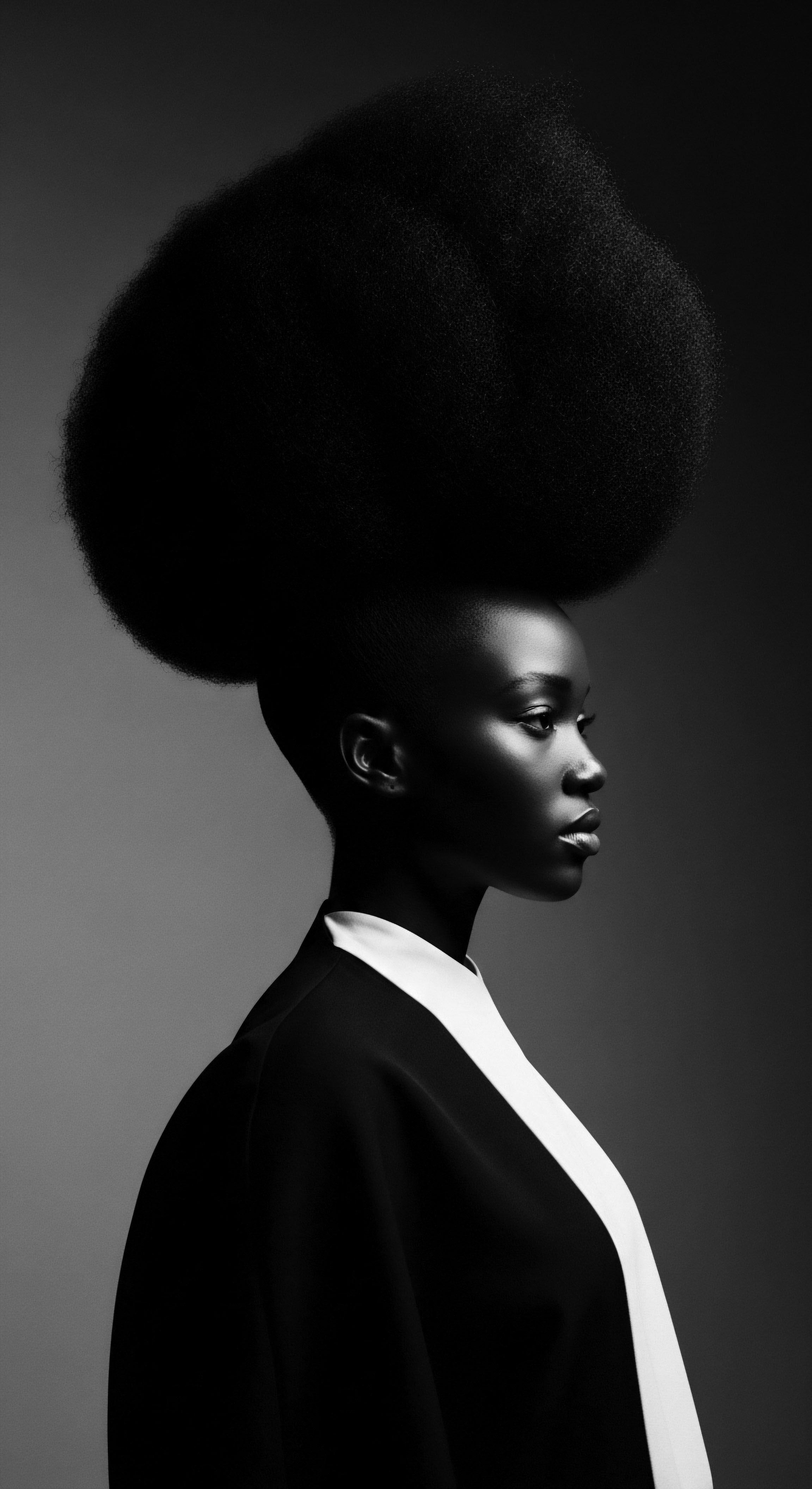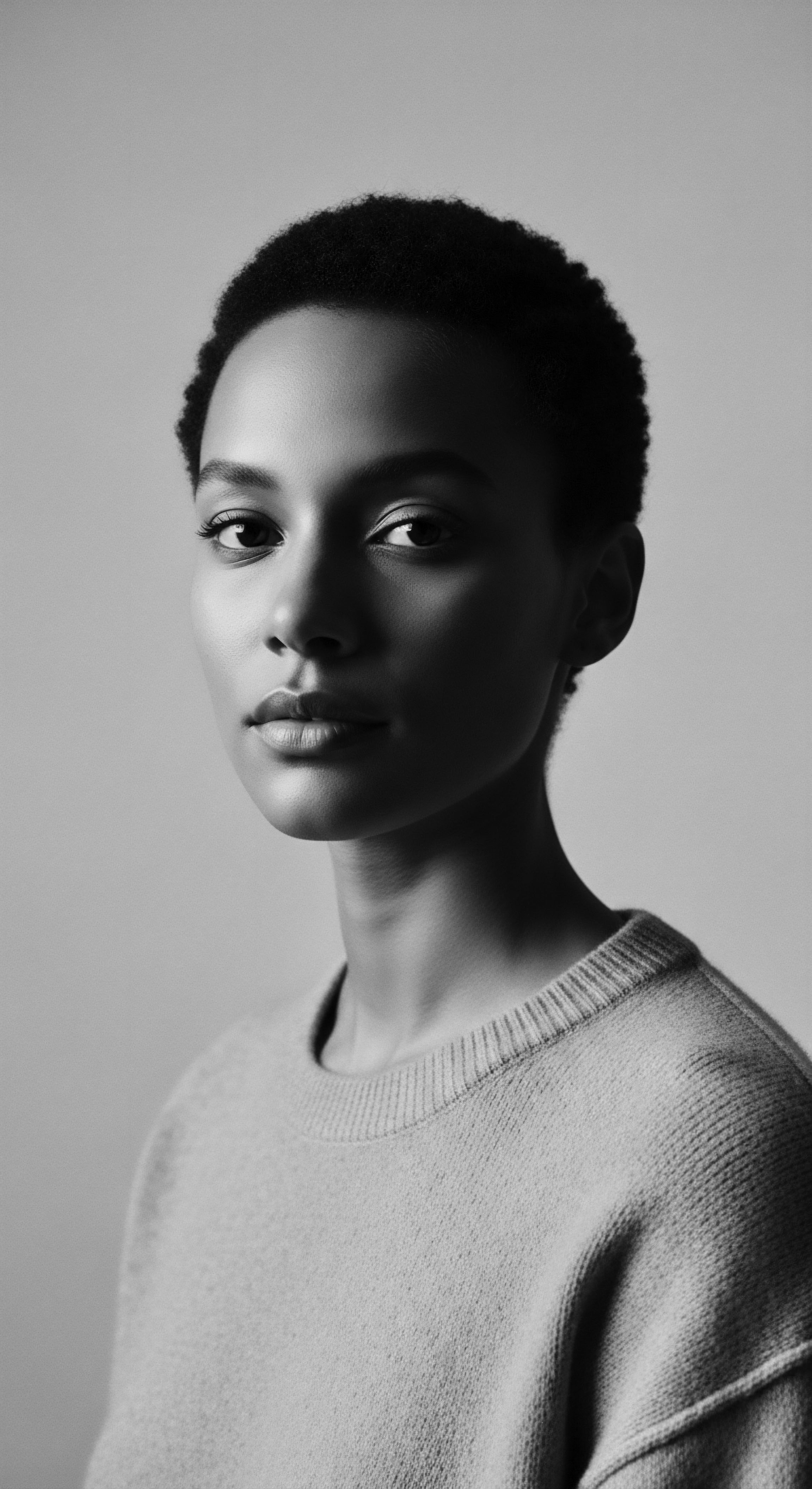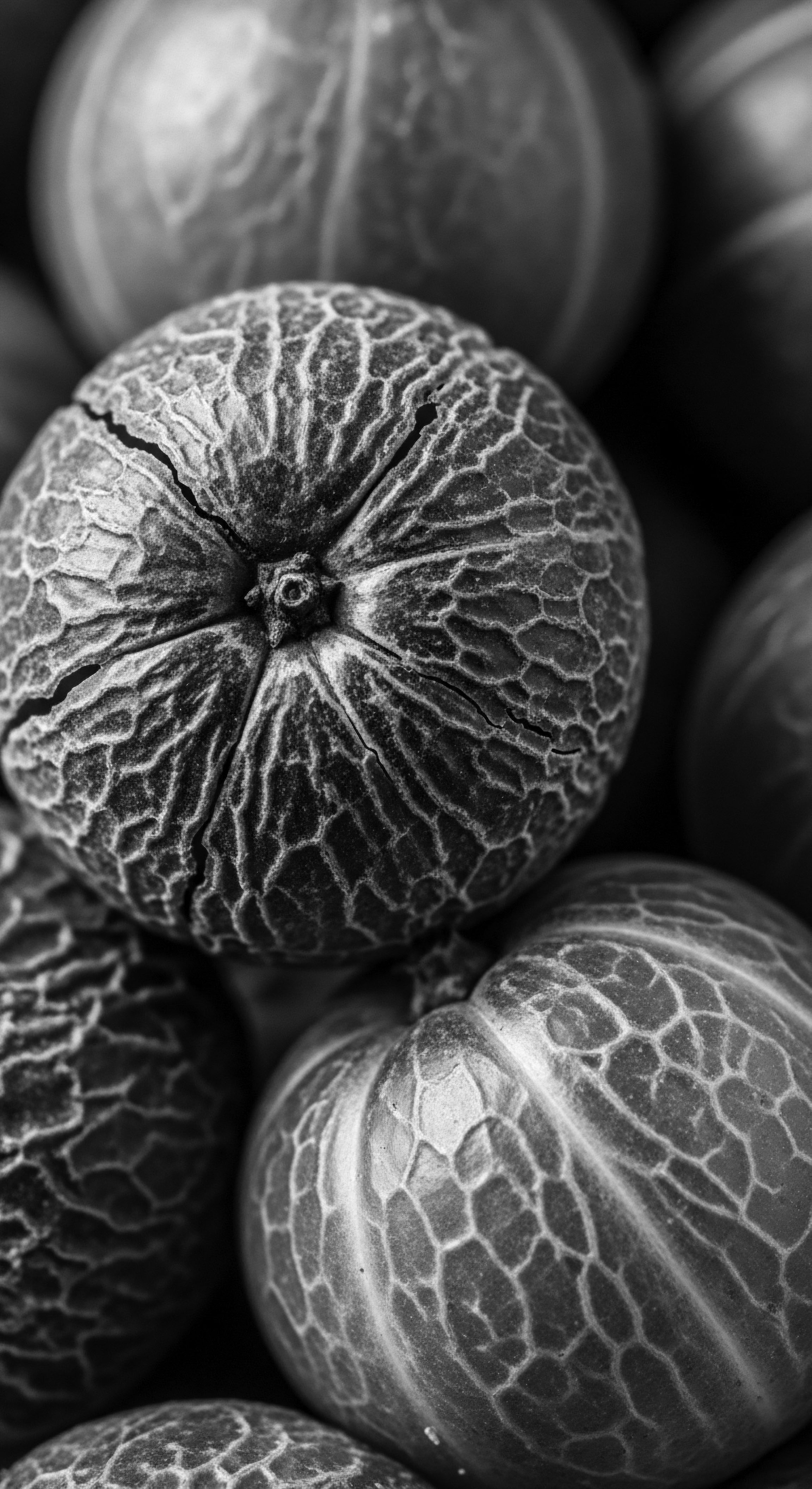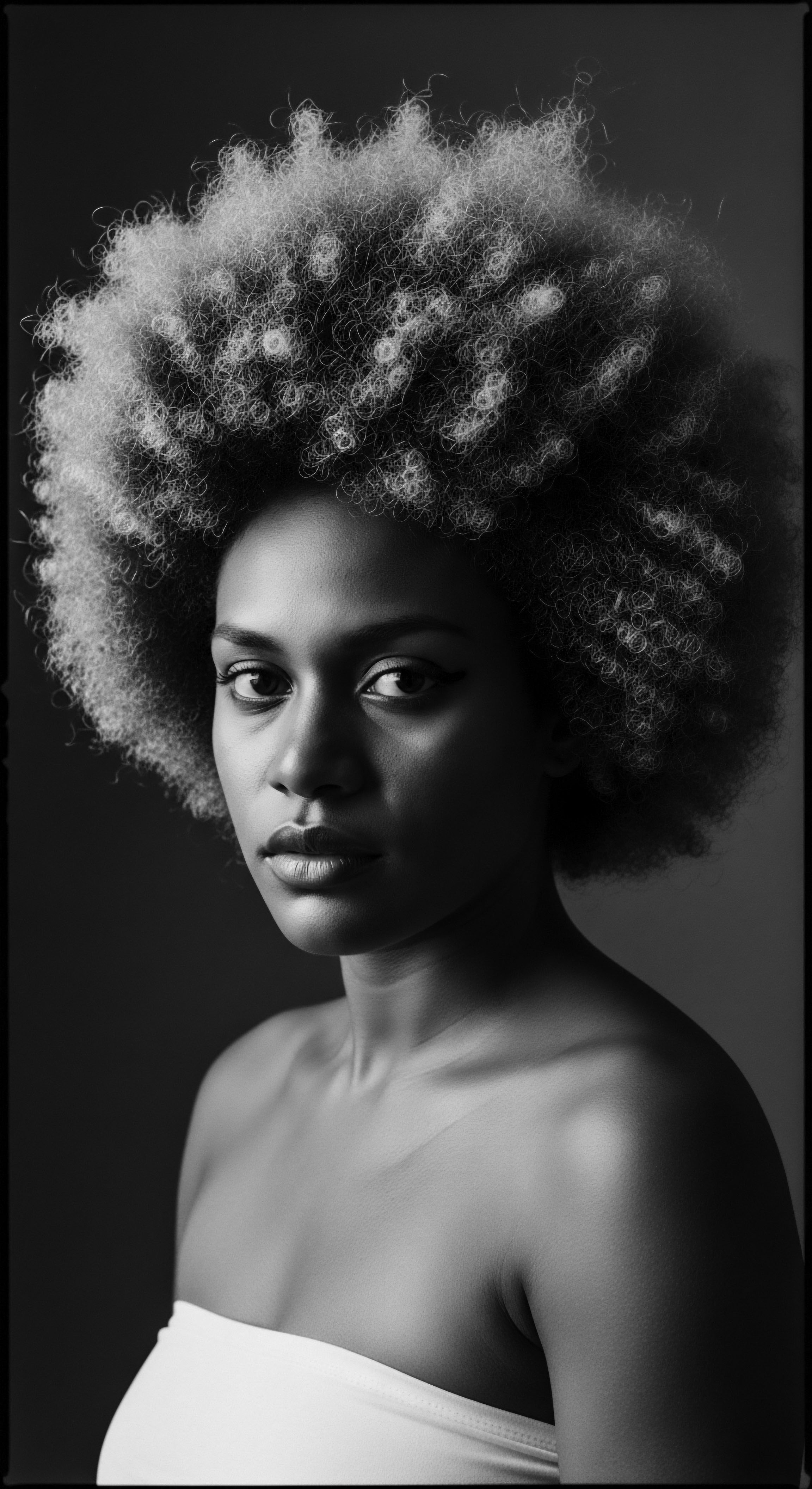
Roots
To truly comprehend how the heritage of textured hair has sculpted beauty standards, we must descend to the very source, tracing the whispers of ancestry within each coil and kink. This exploration commences not in salon chairs or beauty magazines, but in the ancestral lands where textured hair was not just a crowning glory, but a living archive, a spiritual conduit, a social compass. It begins with the fundamental understanding of hair itself, an elemental biology intertwined with millennia of cultural practice.
Across the vast, diverse landscapes of Africa, before the brutal disruptions of enslavement, hair was an undeniable marker of identity. It spoke of age, marital status, tribal affiliation, wealth, and spiritual connection. The way hair was cared for, adorned, and styled was never a trivial pursuit.
It represented a continuum of knowledge, passed from elder to child, etched into the collective memory of communities. This inherited wisdom formed the initial, deeply rooted beauty standards, born from an reverence for hair’s natural form and its profound cultural significance.

What are the Fundamental Components of Textured Hair from an Ancestral Perspective?
From the deepest reach of history, our ancestors understood hair not merely as inert fiber but as a vibrant extension of the self. They might not have possessed electron microscopes, yet their observations of hair’s resilience, its thirst for moisture, and its unique patterns led to sophisticated care practices. The hair strand, in its very structure, reflects its ancestral journey.
Unlike straight hair, the elliptical cross-section of a textured strand, coupled with its varying twists and turns, results in a more open cuticle layer. This inherent characteristic, a biological signature of its origin, means textured hair tends to require more deliberate hydration and protective care.
Ancestral understanding recognized this inherent difference, developing regimens that focused on sealing moisture and protecting the delicate structure. Consider the traditional practices of West African communities ❉ the application of shea butter, palm oil, and various botanical infusions. These were not merely cosmetic choices; they were responses to the hair’s elemental needs, shaped by generations of observation and ingenuity. These practices, born from intimate knowledge of the hair’s nature, defined the earliest beauty ideals ❉ healthy, well-nourished, and vibrant hair, irrespective of its texture classification.

How Did Ancient Societies Classify Textured Hair?
The concept of classifying hair into numerical types (like 3C or 4A) is a relatively recent, Western invention. Historically, hair was understood through its cultural context and social meaning rather than a scientific grading system. Ancient societies, particularly those in Africa, recognized the spectrum of textures through observation of their communities. Hair might be described as “tightly coiled as a ram’s horn,” “softly waving like a river,” or “standing tall like a warrior’s plume.” These descriptions were imbued with meaning, often linking hair to natural phenomena or spiritual significance.
For many indigenous African peoples, hair was not a singular entity but a dynamic, ever-changing part of the body that responded to care, environment, and even spiritual states. The diverse range of textures within a community was celebrated, each variation having its own aesthetic and symbolic value. There was no single “ideal” texture; rather, beauty resided in the health and meticulous styling of whatever texture one possessed. This traditional perspective offers a powerful counterpoint to modern, often rigid, classification systems that can inadvertently perpetuate hierarchies of hair desirability.
The deep, historical understanding of textured hair is not merely an academic pursuit; it is a vital reconnection to ancestral knowledge that defines its intrinsic beauty.
The lexicon of textured hair, therefore, extended beyond simple adjectives. It included verbs describing meticulous styling processes, nouns for specific tools, and phrases denoting communal rituals. The language itself was deeply intertwined with the heritage of care, reflecting a profound respect for the hair’s living quality.
| Traditional Observation Hair's natural thirst for moisture (e.g. observed dryness in arid climates) |
| Modern Scientific Link High porosity due to open cuticle layers; need for emollients and humectants. |
| Traditional Observation Hair's ability to shrink and expand (e.g. after water or protective styles) |
| Modern Scientific Link Elasticity and coil pattern memory, allowing for significant length versatility. |
| Traditional Observation Hair's tendency to tangle (e.g. when not meticulously detangled) |
| Modern Scientific Link Coil structure and friction between individual strands, requiring gentle methods. |
| Traditional Observation Hair's strength and resilience (e.g. when properly cared for and styled) |
| Modern Scientific Link The inherent structural integrity of keratin and disulfide bonds, despite perceived fragility. |
| Traditional Observation This table shows how long-standing ancestral observations about textured hair align with contemporary scientific understanding. |
The growth cycles of textured hair, while biologically universal, were often understood through the lens of seasonal changes or life stages within ancestral communities. Hair growth and loss were seen as natural rhythms, part of a larger interconnectedness with nature and the human experience. Factors influencing hair health, such as diet and environmental conditions, were addressed through traditional healing practices and communal knowledge, underscoring a holistic view of wellbeing that directly shaped the perceived beauty and vitality of hair. This rich heritage forms the foundational understanding that textured hair is inherently beautiful, requiring recognition and care rather than alteration to fit external ideals.

Ritual
The conversation around how textured hair heritage has influenced beauty standards finds a profound echo in the rituals of styling, the very hands-on practices that transform and protect hair. These are not mere aesthetic choices; they are historical declarations, acts of cultural preservation, and expressions of identity that have consistently shaped, challenged, and redefined what is considered beautiful. The art and science of styling textured hair are deeply steeped in ancestral wisdom, practices honed over generations, which continue to resonate in contemporary beauty landscapes.
For countless centuries, the art of styling in African societies was a communal and often sacred act. Braiding, coiling, and twisting were not just about appearance; they were intricate languages. The specific patterns could convey marital status, age, social rank, or even spiritual devotion.
These elaborate styles required immense skill, patience, and a deep understanding of the hair’s properties. The beauty standard here was one of artistry, order, and symbolic communication, a standard directly born from the heritage of textured hair and its inherent versatility.

How Have Ancestral Styling Techniques Endured across Generations?
The techniques we recognize today as foundational—braids, twists, cornrows, bantu knots—are direct descendants of ancient African practices. For example, the cornrow , known in various African languages as amabhanzi or ekpa-edo, dates back thousands of years. Archaeological evidence from ancient Egypt shows depictions of cornrows, and historical accounts affirm their widespread use across the continent for their aesthetic, protective, and communicative properties (Thurman, 1997).
These styles offered a practical solution to managing hair, protecting it from environmental elements, and facilitating cleanliness. Their enduring presence in Black communities worldwide speaks to their efficacy and cultural significance.
The beauty standards linked to these styles were intrinsic to their function and meaning. A well-executed set of cornrows or intricate braids symbolized diligence, skill, and communal connection. They were a testament to the wearer’s patience and the artistry of the stylist. In a world where textured hair was often denigrated, these styles became symbols of resilience, carrying forward a legacy of beauty that was self-defined and internally validated.
Styling textured hair transcends mere aesthetics; it is a ritualistic act connecting us to the enduring artistry and resilience of our ancestral heritage.

What Tools Were Traditionally Employed in Textured Hair Styling?
The traditional toolkit for textured hair was a testament to ingenuity, crafted from the natural world. Combs carved from wood or bone, picks used for lifting and separating coils, and various adornments like shells, beads, and precious metals were all part of this ancestral repertoire. These tools were not simply utilitarian; they were often imbued with cultural significance, passed down through families, and used in ceremonial contexts.
The advent of Western beauty standards, often predicated on straight hair, led to a historical shift away from these heritage-rich practices. The forced assimilation during slavery and subsequent colonial periods saw the suppression of traditional hairstyles, often replaced by those aiming to mimic European textures. This traumatic rupture in the heritage of hair profoundly affected beauty standards, pushing textured hair from a place of reverence to one of perceived inferiority. Yet, the memory of these techniques persisted, often practiced in secret or within the confines of intimate community spaces.
The mid-20th century witnessed a powerful reclamation, a conscious return to these traditional styles. The Black is Beautiful movement saw textured hair, in its natural glory, become a political statement and a celebrated aesthetic. This period marked a profound re-alignment of beauty standards, asserting that textured hair, in its myriad forms, was undeniably beautiful, powerful, and a source of pride. This reclamation was a direct influence of heritage, as ancestral practices were consciously revived and adapted for a modern context.
- Braids ❉ Ancient art forms, often symbolic of social status, age, or tribal affiliation.
- Twists ❉ Versatile styles for protection and definition, popular across various African cultures.
- Bantu Knots ❉ Originated with the Zulu people of Southern Africa, used for styling and setting hair.
The legacy of textured hair styling continues to influence beauty standards today, as natural hair movements gain global momentum. Modern stylists draw directly from these ancient techniques, adapting them with contemporary flair while preserving their cultural integrity. The very notion of “protective styling,” a cornerstone of textured hair care, is a direct inheritance from ancestral practices designed to preserve hair health. This constant dialogue between past and present, between ancestral wisdom and contemporary expression, ensures that the heritage of textured hair remains a dynamic and vital force in shaping the expansive definition of beauty.

Relay
The transmission of knowledge concerning textured hair, from ancestral practices to contemporary understanding, represents a powerful relay, a continuous exchange that informs how textured hair heritage influences beauty standards today. This section delves into the intricate web of holistic care, traditional wisdom, and problem-solving strategies, all rooted in the deep legacy of Black and mixed-race hair. It is a journey that transcends superficial aesthetics, reaching into the realm of wellbeing, cultural affirmation, and the enduring power of self-acceptance.
The concept of “care” for textured hair, as understood through the lens of heritage, extends beyond mere product application. It embodies a holistic approach, a connection to the self and to ancestral rhythms. For generations, communities across Africa and the diaspora viewed hair health as inseparable from overall physical and spiritual wellbeing. This intrinsic link meant that care practices were often integrated with other wellness rituals, utilizing ingredients and techniques passed down through oral tradition and lived experience.

How do Ancestral Wellness Philosophies Guide Contemporary Hair Care Regimens?
Many ancestral wellness philosophies centered on the idea of balance and harmony with nature. This philosophy directly shaped hair care. For instance, the use of natural oils and butters like shea butter (from the African shea tree, Vitellaria paradoxa) and coconut oil (prevalent in coastal African communities and diasporic regions with historical ties to the Caribbean) was not arbitrary.
These ingredients were chosen for their emollient properties, their ability to seal in moisture, and their protective qualities against harsh climates. Modern science now validates these ancestral choices, recognizing their beneficial fatty acid profiles and occlusive properties (Rele & Mohile, 2017).
This ancestral wisdom provides a powerful framework for building personalized textured hair regimens today. Rather than a rigid set of rules, it suggests an approach that is intuitive, responsive to the hair’s needs, and respectful of its natural state. The holistic influence extends to diet, stress management, and even community support, all of which were understood to play a part in one’s overall vitality, including the health and appearance of hair. The beauty standard here becomes one of radiant health, a glow that emanates from within and is reflected in the hair’s condition.

What is the Historical Basis for Nighttime Protective Rituals for Textured Hair?
The nighttime sanctuary, specifically the practice of covering hair with bonnets or headwraps, is a cornerstone of textured hair care with profound historical roots. This ritual extends beyond simple protection from tangles and dryness; it speaks to the historical vulnerability of Black hair and the proactive measures taken to preserve it. In many West African cultures, headwraps and elaborate hair coverings were symbols of status, spirituality, and modesty. After the transatlantic slave trade, these practices, often simplified, persisted as a means of maintaining dignity, hygiene, and protecting hair during forced labor (Byrd & Tharps, 2014).
The bonnet, in its modern iteration, serves as a direct link to this heritage. It is a practical tool that minimizes friction against cotton pillowcases, which can strip hair of moisture and cause breakage, particularly for delicate textured strands. This simple act of protection, rooted in ancestral foresight and adaptation, directly informs a beauty standard that values hair health and longevity. It is a ritual of self-care and preservation, reflecting the deep value placed on textured hair despite external pressures.
The relay of textured hair heritage is a continuous current, flowing from ancestral wisdom to contemporary practices, affirming holistic care as a core beauty standard.
Addressing common textured hair concerns, such as dryness, breakage, and scalp conditions, also draws heavily from this inherited knowledge. Traditional remedies often involved botanical infusions, herbal rinses, and scalp massages to stimulate circulation and maintain balance. For example, the use of Aloe Vera for scalp soothing and moisture, or Fenugreek for strengthening, are practices found in various African and South Asian traditions that have been integrated into modern textured hair care.
These remedies, refined over centuries, formed the basis for problem-solving within the heritage context. They were not about altering the hair’s nature, but about nurturing it to its healthiest state.
The CROWN Act (Creating a Respectful and Open World for Natural Hair) in the United States stands as a powerful, modern example of this relay of heritage in action. This legislation, first enacted in California in 2019, prohibits discrimination based on hair texture and protective hairstyles associated with race (CROWN Act, 2019). It directly challenges discriminatory beauty standards that have historically penalized Black individuals for wearing their natural hair in professional or academic settings.
The Act is a legal recognition of the inherent beauty and cultural significance of textured hair, a direct outcome of generations of struggle and advocacy rooted in the refusal to abandon one’s hair heritage. It signifies a societal shift, however gradual, towards embracing the diverse tapestry of textured hair as a legitimate and valued aspect of beauty.
- Shea Butter ❉ A rich emollient, traditionally used across West Africa for skin and hair protection and moisture.
- Coconut Oil ❉ A versatile oil used for conditioning and sealing, prominent in various diasporic communities.
- Ayurvedic Herbs ❉ Though rooted in South Asia, practices like Henna and Amla for strengthening and conditioning have long crossed cultural boundaries, influencing Black hair care.

Reflection
To journey through the heritage of textured hair is to walk a path illuminated by ancestral wisdom, cultural resilience, and an unwavering spirit of self-definition. From the fundamental understanding of a single coil to the elaborate rituals of styling and the meticulous routines of care, textured hair has consistently carved its own definition of beauty, often in direct opposition to imposed ideals. It is a living, breathing archive of identity, a testament to the enduring power of connection to one’s roots.
The influence of textured hair heritage on beauty standards is not a static historical footnote; it is a dynamic, ongoing dialogue. It manifests in the conscious choices made each day to nourish, protect, and celebrate natural hair. It appears in the resurgence of traditional styles on runways and in mainstream media. It resonates in the legislative battles fought to protect the right to wear one’s hair without fear of discrimination.
Every strand carries the echoes of countless generations, a symphony of resilience and artistry. The ‘Soul of a Strand’ whispers of this profound legacy, inviting us all to recognize that true beauty is found not in conformity, but in the luminous expression of one’s authentic, inherited self.

References
- Byrd, A. D. & Tharps, L. D. (2014). Hair Story ❉ Untangling the Roots of Black Hair in America. St. Martin’s Press.
- CROWN Act (Creating a Respectful and Open World for Natural Hair). (2019). California Assembly Bill 703.
- Rele, A. S. & Mohile, R. B. (2017). Effect of mineral oil, sunflower oil, and coconut oil on prevention of hair damage. Journal of Cosmetic Science, 68(1), 37-43.
- Thurman, H. A. (1997). African Americans on Album Covers ❉ A Guide to Images of African Americans on Record Jackets, 1940-1990. Garland Publishing.
